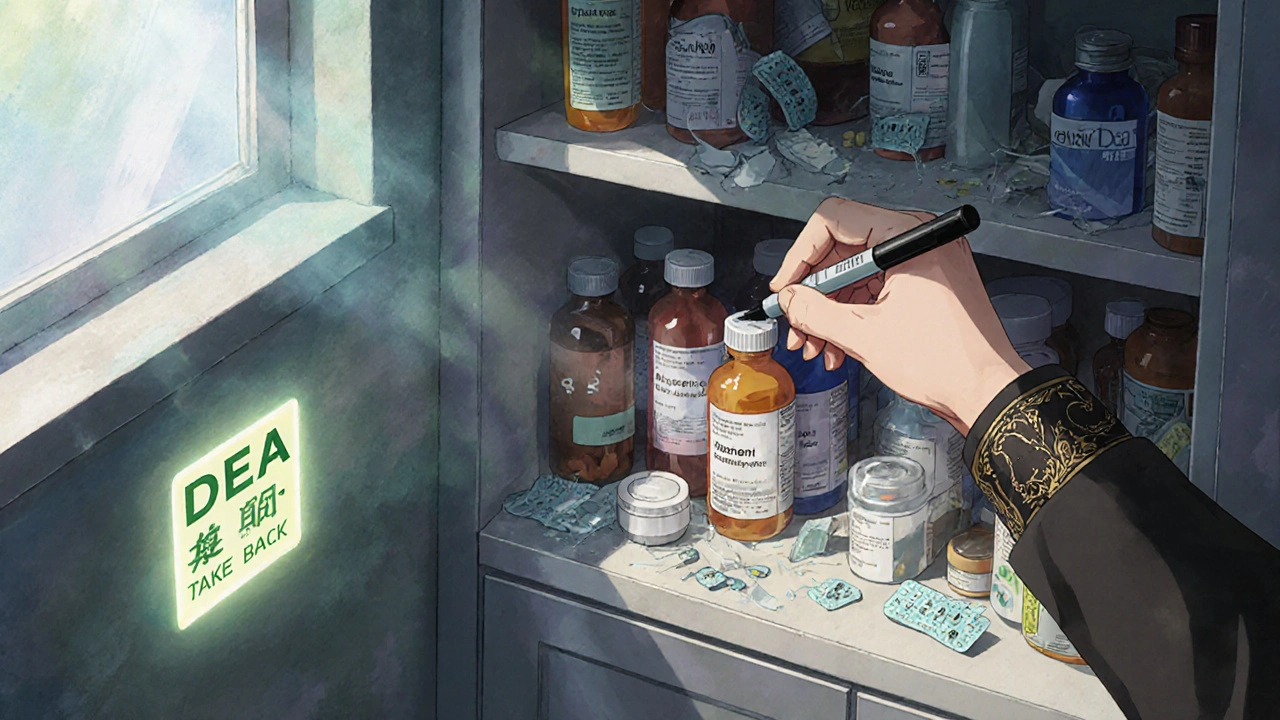How to Prepare Unused Medications for Take-Back Events: A Simple Step-by-Step Guide

Every year, millions of unused pills, patches, and liquids sit in bathroom cabinets, kitchen drawers, and nightstands across the U.S. - and most of them end up flushed, tossed in the trash, or forgotten. But there’s a better, safer way: take-back events. These are organized drop-off days or permanent collection sites where you can safely return unwanted medications so they’re destroyed properly, not polluting waterways or ending up in the hands of someone who shouldn’t have them.
Why Proper Preparation Matters
It’s not enough to just drop off your old meds. If you don’t prepare them correctly, the collection site might turn you away - and that’s not just frustrating, it’s dangerous. The DEA and FDA updated their guidelines in early 2024 to make disposal safer and more consistent. Why? Because 18.4 million Americans misused prescription drugs in 2022, and nearly 70% of those got them from family or friends - often from medicine cabinets. Plus, flushing pills or throwing them in the trash lets harmful chemicals leak into rivers and groundwater. Studies show 80% of U.S. streams contain traces of pharmaceuticals. Proper preparation stops both misuse and pollution.Step 1: Gather All Your Unused Medications
Start by checking every drawer, cabinet, and bag. Don’t forget pet meds, vitamins, ointments, and patches. You can return:- Prescription drugs (including controlled substances like oxycodone or Adderall)
- Over-the-counter pills and liquids
- Transdermal patches (like fentanyl or nicotine)
- Vitamins and supplements
- Pet medications
But leave these out:
- Asthma inhalers or aerosol cans
- Hydrogen peroxide
- Iodine-based products (like Betadine)
- Thermometers (mercury or digital)
- Illicit drugs
If you’re unsure, bring it anyway. Staff at collection sites can tell you what’s accepted. But if you’re preparing ahead, it’s best to know the rules.
Step 2: Remove Personal Information
This is the single most important step - and the one most people mess up. The DEA and HIPAA require you to protect your privacy. You must completely cover or scratch out your name, address, prescription number, and pharmacy details on the bottle or box.Use a permanent marker (like a Sharpie). Go over the label multiple times. If you’re worried about smudging, use white-out or tape over the info, then write over it with the marker. Don’t just scribble lightly - you want it unreadable. In 2023, 41% of rejected submissions were due to incomplete redaction. Staff at collection sites can’t accept anything where your identity is visible.
Step 3: Keep Medications in Original Containers
Most sites - 92% of them nationwide - require you to keep medications in their original bottles or boxes. Why? It helps staff quickly identify what’s being returned and ensures nothing dangerous slips through. If you’ve lost the bottle, here’s what to do:- For pills or capsules: Use a small, sealable plastic container or zip-top bag.
- For liquids: Must be in a sealed container - the original bottle is best. If not available, use a sturdy plastic bottle with a tight cap.
- For patches: Fold them in half with the sticky side facing inward, then place in a sealed bag.
Don’t mix different medications in one container. Even if they’re all yours, keep them separate. The Military Health System and many pharmacies require this. Mixing can cause confusion and lead to rejection.

Step 4: Know What’s Different for Special Items
Some medications need extra care:- Insulin pens: These are accepted at 89% of hospital collection sites but only 32% of retail pharmacies. Call ahead if you’re dropping off at a Walgreens or CVS.
- Transdermal patches: Always fold them sticky-side-in. If you don’t, they can stick to other items or people. This rule is universal - every site requires it.
- Liquids: Never pour them out. Keep them in their original bottles with caps tightly sealed. Some sites will refuse them if they’re in a cup or jar.
Step 5: Find a Collection Site Near You
You don’t have to wait for a take-back day. Over 16,500 permanent collection sites exist across the U.S. - including pharmacies, hospitals, and law enforcement offices. In fact, 71% of Americans live within five miles of one.Use the DEA’s online locator tool to find the closest site. Enter your ZIP code, and it will show you nearby options with hours and accepted items. In Halifax, Nova Scotia, local pharmacies like Shoppers Drug Mart and independent pharmacies participate in Canada’s take-back program. You can also check with your city’s waste management department - many offer year-round drop-offs.
What Happens After You Drop Them Off?
Once you hand over your meds, they’re taken to a licensed facility and incinerated at high temperatures - the only method approved by the EPA and FDA to fully destroy pharmaceuticals. In 2024 alone, Stericycle, one of the largest disposal companies, safely incinerated nearly 30,000 tons of unused medications. That’s the equivalent of removing 6.4 million pounds of chemicals from waterways every year if participation rates rise.
Why So Many People Don’t Participate - And How to Avoid It
A 2023 Johns Hopkins study found that 43% of people didn’t know how to prepare their meds properly. Another 28% skipped take-back events entirely because they were afraid of being turned away. Common mistakes:- Leaving names visible on labels
- Using a coffee cup or yogurt container for liquids
- Mixing pills from different prescriptions
- Bringing inhalers or aerosols
Even if you do everything right, some sites still reject your meds because staff are misinformed. Rural locations have 22% higher rejection rates than cities. If you’re turned away, ask why. Take a photo of the label and call your local pharmacy or health department. Many are now training staff to follow national guidelines more consistently.
What’s Changing in 2025?
The DEA launched "Every Day is Take Back Day" in January 2024 to unify rules across all sites. And 38 states are testing a new standard: no more need for original containers. As long as personal info is removed and meds are sealed in a bag or bottle, they’ll be accepted. This change is expected to boost participation by 22% - and the FDA is funding $8.7 million in public education to make it happen.The goal? Get more people to drop off their old meds - not just once, but every time they clean out their medicine cabinet. Because every pill you return is one less chance for misuse, overdose, or environmental harm.
Final Tip: Make It a Habit
Don’t wait for a take-back day. When you finish a prescription, or when a loved one passes away, or when you switch to a new medication - take the old ones to a drop-off site right away. Keep a small bag in your car or closet for this purpose. It takes five minutes. And it’s one of the simplest, most effective ways to protect your family, your community, and the environment.Can I throw unused medications in the trash?
It’s not recommended. Flushing or trashing meds can contaminate water and soil. The EPA says 80% of U.S. streams have traces of pharmaceuticals from improper disposal. If you can’t get to a take-back site, mix pills with kitty litter or coffee grounds in a sealed container before tossing - but this is a last resort. Always prefer official collection sites.
Do I need to remove the pills from the bottle?
No. Keep pills in their original bottle. Removing them increases the risk of mixing or losing labels. Only take pills out if the original container is missing - then use a sealed plastic bag or small container. Always cover personal info on the bottle, even if the pills are out.
Can I bring expired vitamins to a take-back event?
Yes. Vitamins, supplements, and herbal products are accepted at all DEA-authorized collection sites. Just make sure personal info on the bottle is removed. They’re included because they’re often stored alongside prescription drugs and can be misused or accidentally ingested.
What if I have a lot of medications?
Bring them all. There’s no limit on quantity. If you have multiple bags or boxes, label them clearly with your name (only on the outside, not on the medication containers). Staff at hospitals and pharmacies are used to handling large drop-offs - especially during take-back events or after a death in the family.
Are take-back events free?
Yes. All DEA-authorized collection sites offer free disposal. No ID, no fee, no questions asked. You don’t need to be a patient of the pharmacy or hospital. Anyone can drop off unused medications. This is a public health service funded by federal and state programs.
Why can’t I bring inhalers or aerosols?
Inhalers, spray cans, and aerosols are pressurized containers. They can explode during incineration or handling, posing a safety risk. These items require special recycling through medical waste programs or specific drop-off locations - often at pharmacies that handle hazardous waste. Check with your local pharmacy for alternatives.
Can I drop off medications for someone else?
Yes. You can bring medications for a family member, friend, or even a deceased loved one. Just make sure all personal information on the bottles is removed. If you’re unsure, ask the staff - they’re trained to help in these situations and won’t ask for proof of ownership.
What if I live in a rural area with no nearby drop-off site?
Mail-back programs are available in many states. Some pharmacies and health departments offer prepaid return envelopes. You can also contact your local pharmacy - many will hold your meds until the next take-back event or send them to a central collection point. Don’t let distance stop you. There’s always a way.
Gary Hattis
November 11, 2025 AT 02:26My grandma used to hoard every pill she ever got. Last year, we cleaned out her cabinet and filled three grocery bags. Took her 20 minutes to drive there. She felt better afterward. Like she finally did something right.
Esperanza Decor
November 11, 2025 AT 08:06Deepa Lakshminarasimhan
November 13, 2025 AT 01:47Erica Cruz
November 13, 2025 AT 03:19Also, why is it that every time someone mentions ‘DEA guidelines,’ it’s always the same three bullet points repeated like a broken record? Someone write a better guide.
Johnson Abraham
November 14, 2025 AT 15:05Shante Ajadeen
November 15, 2025 AT 21:03dace yates
November 17, 2025 AT 10:26Danae Miley
November 18, 2025 AT 23:03Charles Lewis
November 19, 2025 AT 03:43Renee Ruth
November 19, 2025 AT 06:00Samantha Wade
November 19, 2025 AT 21:02